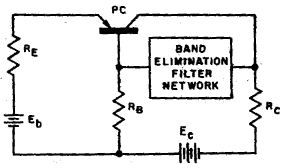|
Phase Shift Oscillator
Author: Leonard Krugman

Fig. 6-14. Phase-shift oscillator
One very stable negative-resistance oscillator is the phase-shift type illustrated in Fig. 6-14. This circuit is particularly useful in the audio range when a low distortion sine-wave signal is required. The resistances RC, RB, and RE are determined by the condition for instability specified by equation 6-1. The phase shift network used is a band-elimination filter at the desired operating frequency. At this frequency, the filter offers maximum attenuation (theoretically an open circuit). At any other frequency, the network attenuation decreases, thereby providing a degenerative feedback path into the base lead. This degeneration counteracts the positive feedback through the base resistor RB. Thus, oscillation is favored only at the operating frequency, namely, the frequency eliminated by the phase shift network. If the network is designed for both phase reversal and minimum attenuation at the operating frequency, it will also be a useful oscillator. Under these conditions the network provides positive feedback into the base, which supplements the normal regenerative signal through the base resistor. The band-elimination filter oscillator is limited to the lower frequencies since proper operation depends on a zero phase shift through the network at the operating frequency.
|


 Transistor Oscillators
Transistor Oscillators  Transistor Phase Shift
Transistor Phase Shift  Phase Shift Oscillator
Phase Shift Oscillator





 Transistor Oscillators
Transistor Oscillators  Transistor Phase Shift
Transistor Phase Shift  Phase Shift Oscillator
Phase Shift Oscillator

